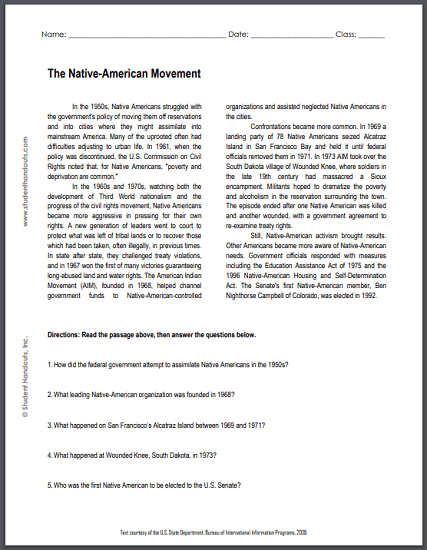Native-American Movement |
In the 1950s, Native Americans struggled with the
government's policy of moving them off reservations and into
cities where they might assimilate into mainstream America. Many
of the uprooted often had difficulties adjusting to urban life.
In 1961, when the policy was discontinued, the U.S. Commission
on Civil Rights noted that, for Native Americans, "poverty and
deprivation are common." In the 1960s and 1970s, watching both the development of Third World nationalism and the progress of the civil rights movement, Native Americans became more aggressive in pressing for their own rights. A new generation of leaders went to court to protect what was left of tribal lands or to recover those which had been taken, often illegally, in previous times. In state after state, they challenged treaty violations, and in 1967 won the first of many victories guaranteeing long-abused land and water rights. The American Indian Movement (AIM), founded in 1968, helped channel government funds to Native-American-controlled organizations and assisted neglected Native Americans in the cities. Confrontations became more common. In 1969 a landing party of 78 Native Americans seized Alcatraz Island in San Francisco Bay and held it until federal officials removed them in 1971. In 1973 AIM took over the South Dakota village of Wounded Knee, where soldiers in the late 19th century had massacred a Sioux encampment. Militants hoped to dramatize the poverty and alcoholism in the reservation surrounding the town. The episode ended after one Native American was killed and another wounded, with a government agreement to re-examine treaty rights. Still, Native-American activism brought results. Other Americans became more aware of Native-American needs. Government officials responded with measures including the Education Assistance Act of 1975 and the 1996 Native-American Housing and Self-Determination Act. The Senate's first Native-American member, Ben Nighthorse Campbell of Colorado, was elected in 1992. |
 |
 |
|---|
| Directions: Read the text above, then answer the questions below. 1. How did the federal government attempt to assimilate Native Americans in the 1950s? 2. What leading Native-American organization was founded in 1968? 3. What happened on San Francisco's Alcatraz Island between 1969 and 1971? 4. What happened at Wounded Knee, South Dakota, in 1973? 5. Who was the first Native American to be elected to the U.S. Senate? Click here to print. |
Text courtesy of the U.S. State Department, Bureau of International Information Programs, 2005 |









